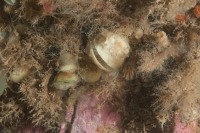
(Photo: Claire Goodwin)
Northern Lamp Shell
Terebratulina septentrionalis
Clam-like shell with two valves attached onto rock by a short stem. Usually around 12 millimetres in length but can be up to 31 millimetres. Shell pale yellow to brown but sometimes covered with encrusting sponge. While lamp shells may resemble bivalve molluscs, they are actually in a different Phylum.
Authority
Couthouy, 1838
Classification Details
Phylum: Brachiopoda (lamp shells); Class: Rhynchonellata (articulate lamp shells).
Habitat
Found attached onto bedrock. They particularly favour shaded bedrock such as caves and the undersides of boulders. They also grow on the shells of the scallop Placopecten magellanicus. This species is reported from Nova Scotia to New England in the northwest Atlantic. There are also records from Norway and Scotland. Most common at depths shallower than 35 metres but recorded down to 750 metres. An important component of the rock-dwelling life of the Quoddy region and can occur in densities of over 600 individuals per square metre.
Diet
Filter feed using a special structure called a lophophore. This crown of tentacles creates a feeding current. Particles are then trapped in mucus on the tentacles and passed down to the mouth. The diet consists primarily of phytoplankton.
Reproduction
Lamp shells can be male or female. Males shed sperm into the water, and the female takes it in to fertilize her eggs internally. She broods the embryos and larvae until releasing them for their short planktonic phase. They then settle on the seabed.
Fun Facts
Lamp shells were very abundant during the Paleozoic Era when there were over 30 000 different species. A mass extinction 250 million years ago wiped most of them out and now there are only 391 living species.
References
Mah C (2013) Five things to know about brachiopods http://echinoblog.blogspot.com/2013/11/basic-brachiopoda-5-things-to-know.html Accessed online 20 January 2020. Martinez AJ (2019) Marine life north Atlantic. Digital application http://marinelifeofthenorthatlantic.com/ Accessed online 20 January 2020. Webb GR, Logan A and Noble JPA (1976) Occurrence and significance of brooded larva in a recent brachiopod, Bay of Fundy, Canada. Journal of Paleontology 50, 869–871. Witman JD, Cooper RA (1983) Disturbance and contrasting patterns of population structure in the brachiopod Terebratulina septentrionalis (Couthouy) from two subtidal habitats. Journal of Experimental Marine Biology and Ecology 73: 57–79. World Register of Marine Species (2020). Terebratulina septentrionalis (Couthouy, 1838). Accessed at: http://www.marinespecies.org/aphia.php?p=taxdetails&id=104056 Accessed online 22 January 2020.

